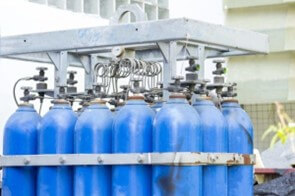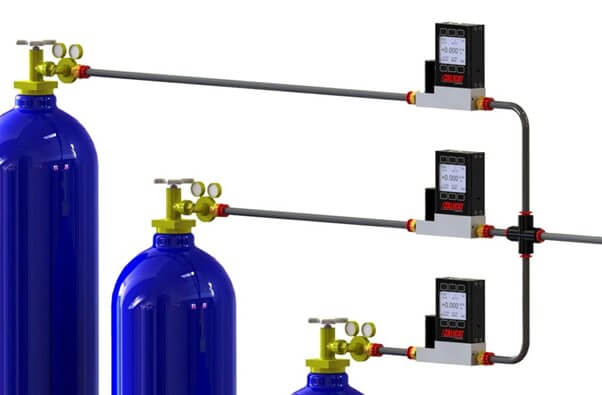Mixing Gases with Versatile Flow Control

As we all know, custom gas mixes are inclined to be expensive and are often delivered in canisters that cannot be returned to the supplier and are difficult to recycle or be discarded. Furthermore when these canisters are left unused over time stratification of the gasses is likely to occur.
How can costs be reduced? By having a supply of pure gasses allows you to adjust the concentration of a constituent for a different end result. Its understandable why many processors mix gasses on site.
Dynamic gas mixtures
In a dynamic system, your mixture may not always be 75% Gas 1 + 25% Gas 2. How do you adjust if your mixture changes to 25% Gas 1 + 75% Gas 2 the next day, and then changes again to 50% Gas 2 + 50% Gas 3 two days later?.
When selecting flow controllers for a mixing operation it is vital that careful consideration be taken of your potential mixes.
Pressure feedback
Continuous pressure becomes important in numerous mixing applications. Bad welds occur in welding when there is a loss of pressure in the shield gas. Due to gas mixing systems not being on 24/7, as well as the change of demand due to multiple systems coming on or offline, pressure loss occurs.
Software
To guarantee a system delivers gas efficiently, good pressure sensing, an adequate flow control and source need to be provided. Building a system and having all components of the system integrated and working concurrently is crucial and should be completed by a Software programmer at the mixing site.
Mixing gases with flexible mass flow controllers

Lab Unlimited offer mass flow controllers that have beneficial features making them an optimal solution for custom gas mixing systems:
- Easily switch between 98+ gases and 20 custom-defined gas mixtures on the fly | A mixer initially set up to blend ethane, methane, and hydrogen may be quickly reconfigured to blend nitrogen, argon, and helium. Having a controller for each gas in your process provides fast and accurate control of your mixture. If you need to measure a mixture, whether pre-mixed or mixed on site, the mixed gas recipe can be programmed into the mass flow controller using the specialised software.
- One device can be used to control pressure or mass flow | Using the pressure control loop on the mass flow controller will responsively increase or decrease flow rates based on pressure readings at each station.
- Wide 10,000:1 controllable range for each gas & mixture | A 10 SLPM mass flow controller will flow accurately down to 1 SCCM. This makes it easier to ensure your device can handle the maximum and minimum flow rates required to operate in all likely conditions. Controllers configured for 1 SLPM full scale of air will remain at 1 SLPM full-scale, whether flowing H2 or SF6.
- Multi-drop RS-232 or RS-485 interface | Read and set all of the mass flow controllers through a common RS-232 or RS-485 serial interface.
- Easy system integration using BB9 multi-drop box and FlowVision™ gas blending software | Simplify system integration and control up to 10 devices at once. LabVIEW drivers are also available to integrate these devices into a LabVIEW interface for control of the mixing system.
Gas mixing systems flowing to pressures near or above atmospheric pressure is shown to be typical in the above provided figure illustrating a system of components. Control valves are between the measurement head and vacuum chamber, which is also where the controllers need to be constructed if exit pressures in the vacuum range are a necessity to the application.
Looking for a turnkey gas mixing system? Check out Fusion Flow Technologies provided by Lab Unlimited
The reduction of gas separation and stratification can be achieved by supplying a turbulent mixing tube in the flow path downstream of the mixed components. Third-party sources provide the cost-efficient components in various different materials.
